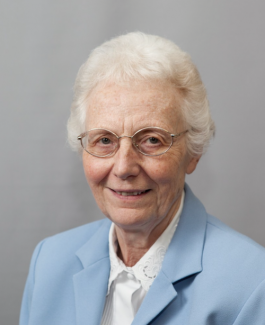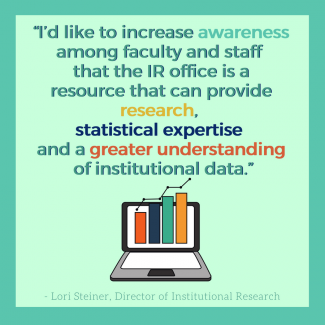Most, if not all, universities participate in institutional research — a practice which involves collecting and reporting information to government bodies, the public and various college guide publishers.
With all that goes on behind the scenes to inform campus decision-making, Director of Institutional Research Lori Steiner sheds some light on the layers of work required for institutional research.
What is institutional research?
The Newman Institutional Research (IR) office is responsible for gathering and summarizing institutional data to derive and communicate meaningful information. IR is a service provider to administrators, faculty, staff, students and the external community — as well as anybody requesting information or research involving institutional data.
“IR can serve as a reliable, authoritative source for information about the institution,” Director of Institutional Research Lori Steiner said. “It can support strategic planning, policy formation and decision-making across the university.”

IR presents and makes inferences about data to help inform decisions regarding student success, student satisfaction, program outcomes, financial sustainability and enrollment trends. IR can serve as a resource by providing data and information for writing grant proposals, program reviews and accreditations.
“A benefit of IR is its understanding of institutional data and its capacity to combine, analyze and interpret data resulting from several operational activities of the university,” Steiner said. “IR provides an institution-wide view.”
History of IR at Newman
Steiner explained that it was rare to see active computer use in the household until the 1970s, which was when the desire for data — and loads of it — erupted.
“You have to turn all the data you have into information, and then find a way to make it meaningful,” she said. “And that’s my job here — to take this plethora of information and data that we have, and we have tons, and ask ‘What does all this mean for institutional effectiveness, student satisfaction and student success?’
“It’s a huge job, and it’s not just a one-person job, either,” she added. “IR works closely with the Registrar’s Office, Financial Aid and Administrative Computing. We compile data and request assistance from these departments as well as Enrollment Management, Human Resources, the Business Office, Career Services, Student Support Services, administrators, faculty and staff.”
The field of IR developed more than 50 years ago to support the improvement of postsecondary institutions through data-informed decision support. IR historically has provided services to the president, chief academic officer and external organizations requiring or requesting information.
At Newman, these tasks were primarily shared between the Registrar’s Office and an additional half-time position, Steiner said. With demand for information growing across the university, the chief academic officer in 2015 created a full-time position, the director of institutional research.
“One of the most rewarding aspects of my position is being able to make a difference in institutional improvement and effectiveness by providing evidence of need in specific areas,” Steiner said. “It’s always been student-focused, but I think I can intentionally work toward this goal by asking, ‘How does this question, direction or research improve the student experience?’ I find that very enjoyable.
“All of these external requests and surveys are important because they are a reflection of who we are to the broader community,” she added. “So it’s crucial that the information I provide is correct and reflects that which is being published even on the local, national and regional levels.”
People of impact
Steiner said that in addition to her work in institutional research, she likes to keep her foot in the classroom.
“I teach one statistics course every semester at Newman,” she said. “I know the provost would like to take that burden away from me, but I really think it’s good because it always keeps me connected with the students. It reminds me of my purpose here.”

Sister JoAnn Mark, ASC, worked alongside Steiner as director of transfer student orientation and retention and institutional research. Mark left Newman in 2015 after receiving an invitation to be the executive director of the Partnership for Global Justice, but has recently returned to Newman.
“Sister JoAnn is now volunteering her time for a while and we’re taking advantage of it,” Steiner said with a smile. “Eventually, she is going to come on part time to work with institutional research.”
“I’ve invested a lot of time and energy, love and prayers into this place,” Mark said. “When Lori (Steiner) first came on board with all of her expertise, the administration just said, ‘Go for it,’ and it turned out really great.”
Steiner added, “And then Sister JoAnn was gone (working for the Partnership of Global Justice) and I thought, ‘I have to figure this out all by myself.’ But (her) notes were meticulous, and I remember thinking, ‘Oh my gosh, this is like a treasure.’
“I would also say the two offices that really helped get me going when I first started are the Registrar’s Office and Administrative Computing,” Steiner said. “They were each a huge help and were so supportive.”
A resource for faculty and staff
“Almost daily, I receive a request for information from an agency of government, the publisher of a higher education directory, an outside researcher or some other source,” Steiner said.
Steiner said that in the past year, the Academic Affairs Office, faculty and staff have requested information or research on average class size, interrater reliability for program accreditation; grade differentials by demographics and courses; enrollment trends within programs and courses; enrollment trends by student types and demographics; diversity in the honors program; and research for grant applications and assessments.
“I want people to know that this office is designed in such a way that we have expertise in statistics and research,” she said. “I’d like to increase awareness among faculty and staff that the IR office is a resource that can provide research, statistical expertise and a greater understanding of institutional data.”
With a smile, Sister JoAnn added, “I think that being able to see or get a picture of the university that is based on real numbers and not just off hearsay is a big advantage. And sometimes what we see surprises us, so it’s good to be surprised, right?”
What sets Newman IR apart
Most larger universities have an IR office with several staff, which allows the office to provide full-time attention to individual types of activities, Steiner said. Multiple staff may also bring varying levels of expertise in research, statistics, data analytics and programming. If the larger university has a greater amount of technological tools, they may also have extra help with communication across the university, statistical analyses and the creation of dashboards.
“One advantage of a smaller university is the personal relationships that can be formed (among) the IR office, other departments and the customers it serves,” Steiner said. “I believe these relationships result in an increased understanding of the services and data created by other departments as well as customers’ needs.”
To view the Newman University fact books for more student statistics, click here.



